coolant level JEEP RENEGADE 2014 1.G Owners Manual
[x] Cancel search | Manufacturer: JEEP, Model Year: 2014, Model line: RENEGADE, Model: JEEP RENEGADE 2014 1.GPages: 212, PDF Size: 17.48 MB
Page 40 of 212
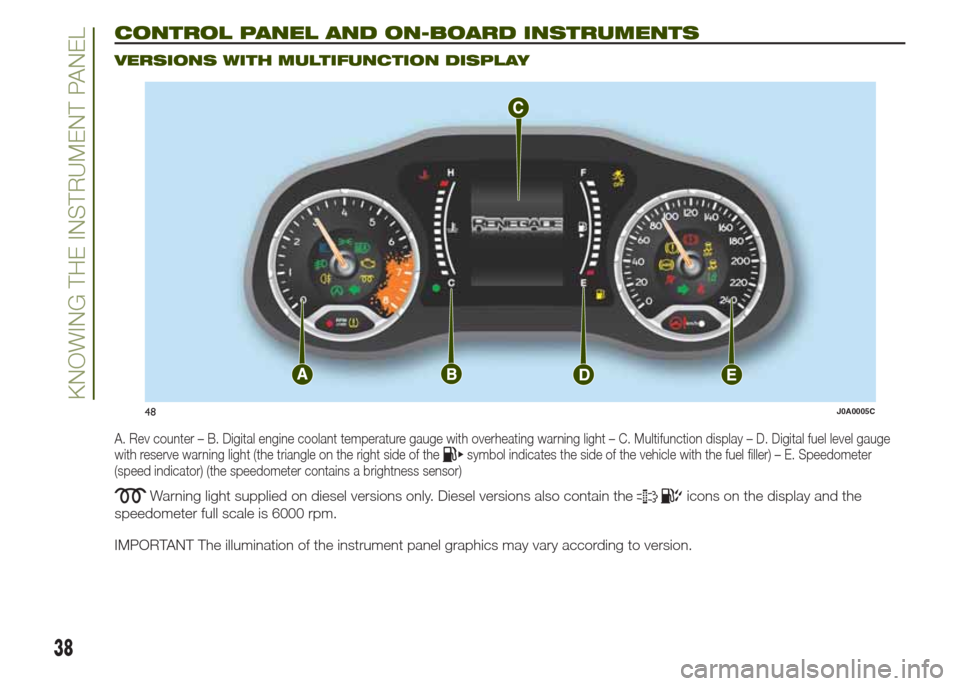
CONTROL PANEL AND ON-BOARD INSTRUMENTS.
VERSIONS WITH MULTIFUNCTION DISPLAY
A. Rev counter β B. Digital engine coolant temperature gauge with overheating warning light β C. Multifunction display β D. Digital fuel level gauge
with reserve warning light (the triangle on the right side of thesymbol indicates the side of the vehicle with the fuel filler) β E. Speedometer
(speed indicator) (the speedometer contains a brightness sensor)
Warning light supplied on diesel versions only. Diesel versions also contain theicons on the display and the
speedometer full scale is 6000 rpm.
IMPORTANT The illumination of the instrument panel graphics may vary according to version.
48J0A0005C
38
KNOWING THE INSTRUMENT PANEL
Page 41 of 212
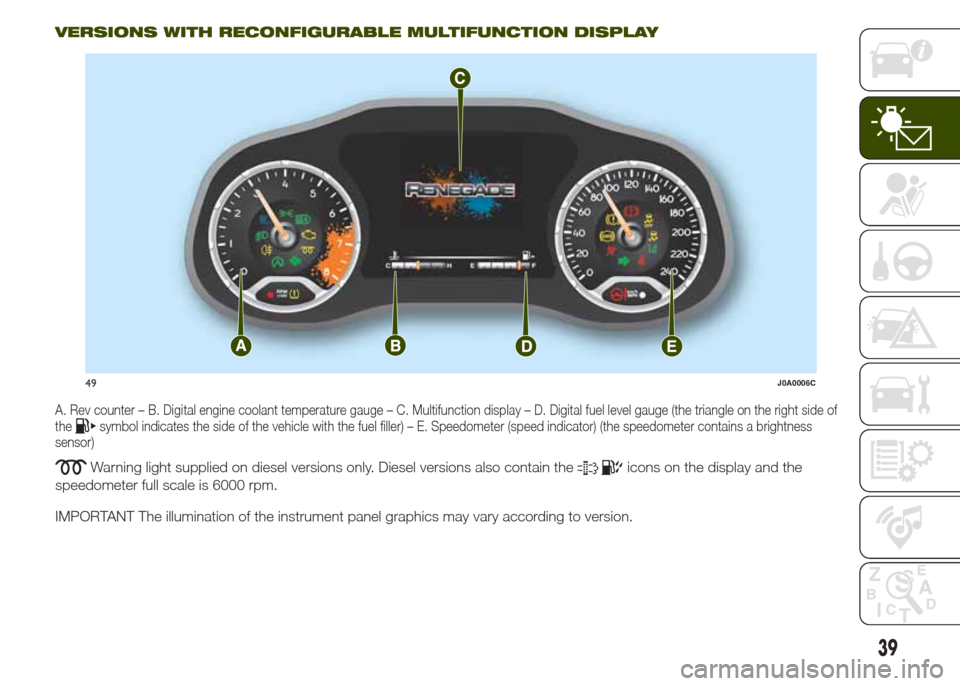
VERSIONS WITH RECONFIGURABLE MULTIFUNCTION DISPLAY
A. Rev counter β B. Digital engine coolant temperature gauge β C. Multifunction display β D. Digital fuel level gauge (the triangle on the right side of
thesymbol indicates the side of the vehicle with the fuel filler) β E. Speedometer (speed indicator) (the speedometer contains a brightness
sensor)
Warning light supplied on diesel versions only. Diesel versions also contain theicons on the display and the
speedometer full scale is 6000 rpm.
IMPORTANT The illumination of the instrument panel graphics may vary according to version.
49J0A0006C
39
Page 42 of 212
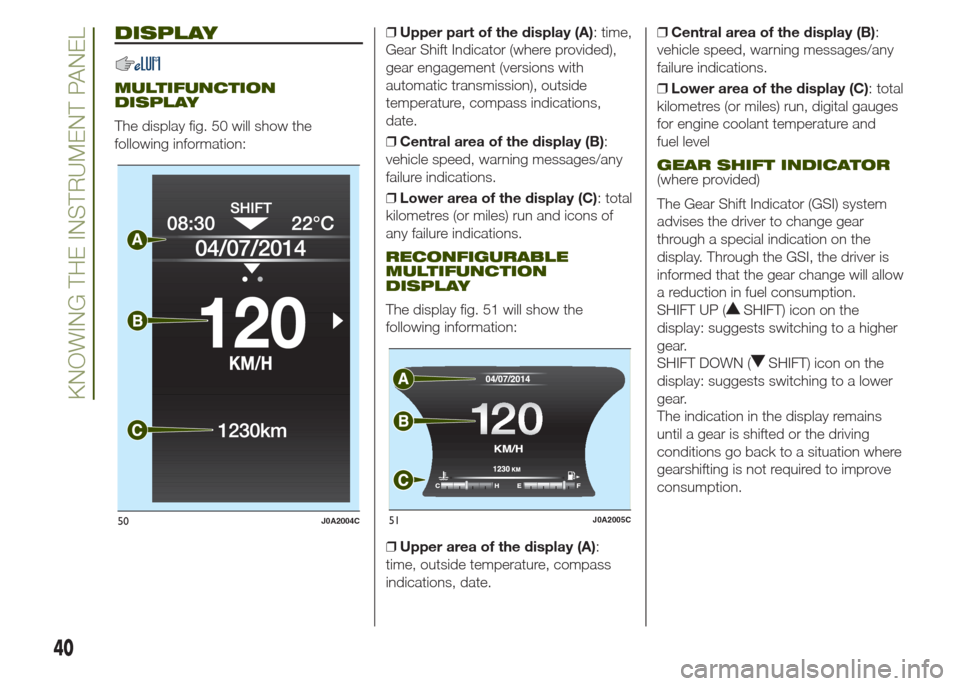
DISPLAY
MULTIFUNCTION
DISPLAY
The display fig. 50 will show the
following information:βUpper part of the display (A): time,
Gear Shift Indicator (where provided),
gear engagement (versions with
automatic transmission), outside
temperature, compass indications,
date.
βCentral area of the display (B):
vehicle speed, warning messages/any
failure indications.
βLower area of the display (C): total
kilometres (or miles) run and icons of
any failure indications.
RECONFIGURABLE
MULTIFUNCTION
DISPLAY
The display fig. 51 will show the
following information:
βUpper area of the display (A):
time, outside temperature, compass
indications, date.βCentral area of the display (B):
vehicle speed, warning messages/any
failure indications.
βLower area of the display (C): total
kilometres (or miles) run, digital gauges
for engine coolant temperature and
fuel level
GEAR SHIFT INDICATOR(where provided)
The Gear Shift Indicator (GSI) system
advises the driver to change gear
through a special indication on the
display. Through the GSI, the driver is
informed that the gear change will allow
a reduction in fuel consumption.
SHIFT UP (
SHIFT) icon on the
display: suggests switching to a higher
gear.
SHIFT DOWN (
SHIFT) icon on the
display: suggests switching to a lower
gear.
The indication in the display remains
until a gear is shifted or the driving
conditions go back to a situation where
gearshifting is not required to improve
consumption.
50J0A2004C
12 0120
51J0A2005C
40
KNOWING THE INSTRUMENT PANEL
Page 48 of 212
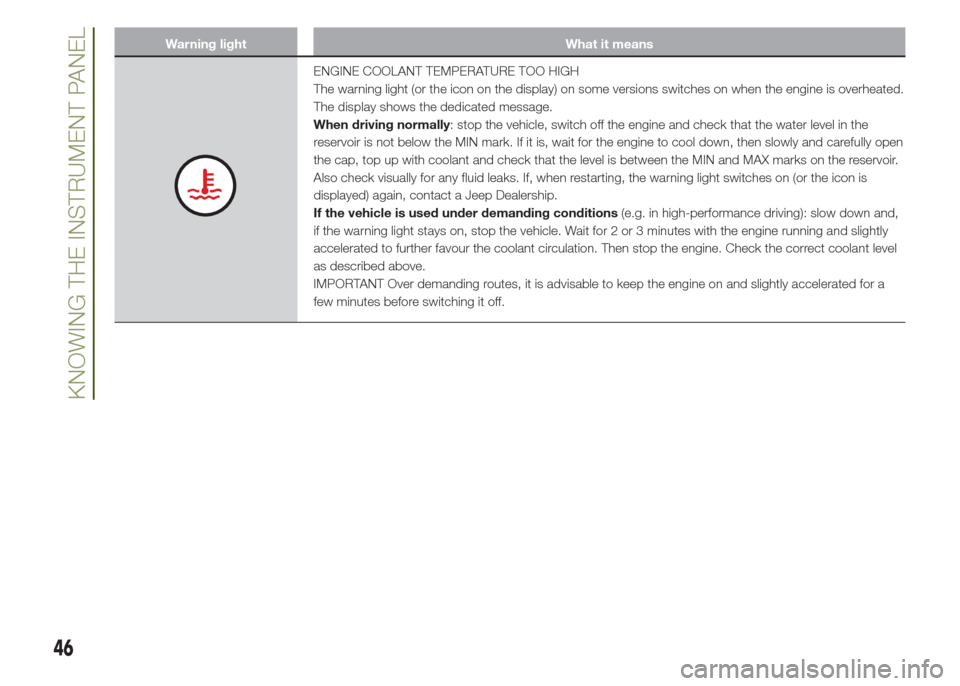
Warning light What it means
ENGINE COOLANT TEMPERATURE TOO HIGH
The warning light (or the icon on the display) on some versions switches on when the engine is overheated.
The display shows the dedicated message.
When driving normally: stop the vehicle, switch off the engine and check that the water level in the
reservoir is not below the MIN mark. If it is, wait for the engine to cool down, then slowly and carefully open
the cap, top up with coolant and check that the level is between the MIN and MAX marks on the reservoir.
Also check visually for any fluid leaks. If, when restarting, the warning light switches on (or the icon is
displayed) again, contact a Jeep Dealership.
If the vehicle is used under demanding conditions(e.g. in high-performance driving): slow down and,
if the warning light stays on, stop the vehicle. Wait for 2 or 3 minutes with the engine running and slightly
accelerated to further favour the coolant circulation. Then stop the engine. Check the correct coolant level
as described above.
IMPORTANT Over demanding routes, it is advisable to keep the engine on and slightly accelerated for a
few minutes before switching it off.
46
KNOWING THE INSTRUMENT PANEL
Page 150 of 212

SCHEDULED
SERVICING
Correct servicing is crucial for
guaranteeing a long life for the vehicle
under the best conditions. For this
reason, Jeep has planned a series of
checks and services at fixed distance
intervals and, where provided, at fixed
time intervals, as described in the
Scheduled Servicing Plan.
Before each service, it is always
necessary to carefully follow the
instructions in the Scheduled Servicing
Plan (e.g. periodically check level of
fluids, tyre pressure, etc.).
Scheduled Servicing is offered by all
Jeep Dealerships according to a set
time schedule. If, during each
operation, in addition to the ones
scheduled, the need arises for further
replacements or repairs, these may
be carried out with your explicit
agreement only. If your vehicle is used
frequently for towing, the interval
between one service operation and the
next should be reduced.IMPORTANT Scheduled Servicing
Coupons are required by the
Manufacturer. Failure to have them
carried out may invalidate the warranty.
It is advisable to inform a Jeep
Dealership of any small operating
irregularities without waiting for the next
service.
PERIODIC CHECKS
Every1,000km or before long
journeys, check and if necessary, top
up: engine coolant level; brake fluid
level; screen washer fluid level; tyre
inflation pressure and condition; lighting
system operation (headlights, direction
indicators, hazard warning lights, etc.);
screen washer/wiper system operation
and positioning/wear of windscreen/
rear window wiper blades.
Every3,000km, check and top up if
required: engine oil level.
HEAVY-DUTY USE OF THE
VEHICLE
If the vehicle is used under one of the
following conditions: towing a trailer
or caravan; dusty roads; short (less
than 7-8 km), repeated journeys with
sub-zero outside temperatures; engine
often idling or driving long distances
at low speed or long periods of
inactivity, the following checks must be
carried out more often than indicated
in the Scheduled Servicing Plan:βcheck front disc brake pad condition
and wear;
βcheck cleanliness of bonnet and
luggage compartment locks,
cleanliness and lubrication of linkage;
βvisually inspect condition of: engine,
gearbox, transmission, pipes and hoses
(exhaust/fuel system/brakes) and
rubber elements (boots/sleeves/
bushes, etc.);
βcheck battery charge and battery
fluid level (electrolyte);
βvisually inspect condition of the
accessory drive belts;
βcheck and, if necessary, change
engine oil and replace oil filter;
βcheck and, if necessary, replace
pollen filter;
βcheck and, if necessary, replace air
cleaner.
On versions with automatic
transmission, change transmission oil
and replace oil filter every 60,000 km
(40,000) or every 4 years.
148
SERVICING AND MAINTENANCE
Page 151 of 212

SCHEDULED SERVICING PLAN (petrol versions)
The checks listed in the Scheduled Servicing Plan, after reaching 120,000 km/8 years, must be cyclically repeated starting from
the first interval, thus following the same intervals as before.
Thousands of miles 9 18 27 36 45 54 63 72 81 90
Thousands of kilometres 15 30 45 60 75 90 105 120 135 150
Years12345678910
Check tyre condition/wear and adjust pressure, if
necessary. Check TireKit recharge (where provided) expiry
dateββββββββββ
Check operation of lighting system (headlights, direction
indicators, hazard warning lights, luggage compartment,
passenger compartment, glove compartment, instrument
panel warning lights, etc.)ββββββββββ
Check and, if necessary, top up fluid levels (engine
coolant, hydraulic clutch/brakes, screen washer, battery,
etc.)ββββββββββ
Check exhaust emissions/smokinessββββββββββ
Use the diagnosis socket to check supply/engine
management system operation, emissions and, where
provided, engine oil degradationββββββββββ
Visually inspect condition of: exterior bodywork,
underbody protection, pipes and hoses (exhaust, fuel
system, brakes), rubber elements (gaiters, sleeves,
bushes, etc.)βββββ
Check windscreen/rear window wiper blade position/wearβββββ
149
Page 154 of 212
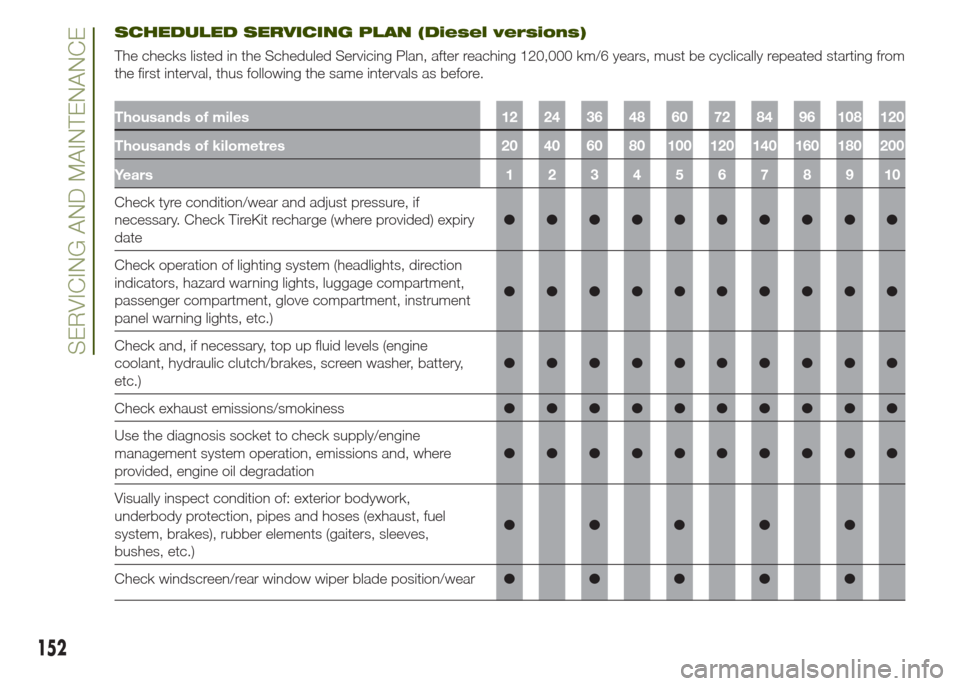
SCHEDULED SERVICING PLAN (Diesel versions)
The checks listed in the Scheduled Servicing Plan, after reaching 120,000 km/6 years, must be cyclically repeated starting from
the first interval, thus following the same intervals as before.
Thousands of miles 12 24 36 48 60 72 84 96 108 120
Thousands of kilometres 20 40 60 80 100 120 140 160 180 200
Years12345678910
Check tyre condition/wear and adjust pressure, if
necessary. Check TireKit recharge (where provided) expiry
dateββββββββββ
Check operation of lighting system (headlights, direction
indicators, hazard warning lights, luggage compartment,
passenger compartment, glove compartment, instrument
panel warning lights, etc.)ββββββββββ
Check and, if necessary, top up fluid levels (engine
coolant, hydraulic clutch/brakes, screen washer, battery,
etc.)ββββββββββ
Check exhaust emissions/smokinessββββββββββ
Use the diagnosis socket to check supply/engine
management system operation, emissions and, where
provided, engine oil degradationββββββββββ
Visually inspect condition of: exterior bodywork,
underbody protection, pipes and hoses (exhaust, fuel
system, brakes), rubber elements (gaiters, sleeves,
bushes, etc.)βββββ
Check windscreen/rear window wiper blade position/wearβββββ
152
SERVICING AND MAINTENANCE
Page 157 of 212
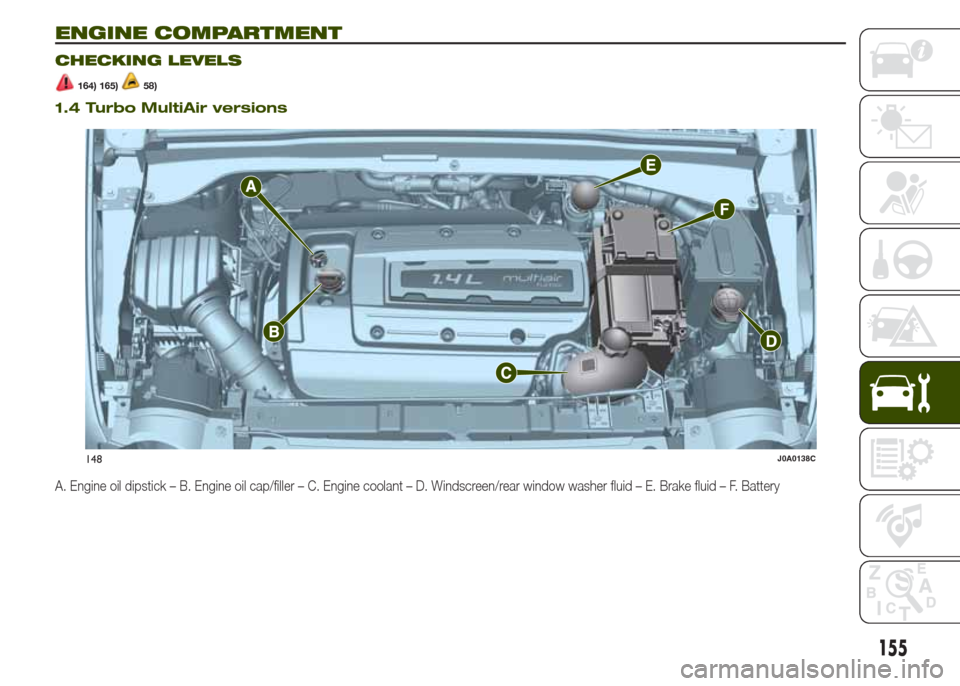
ENGINE COMPARTMENT.
CHECKING LEVELS
164) 165)58)
1.4 Turbo MultiAir versions
A. Engine oil dipstick β B. Engine oil cap/filler β C. Engine coolant β D. Windscreen/rear window washer fluid β E. Brake fluid β F. Battery
148J0A0138C
155
Page 160 of 212
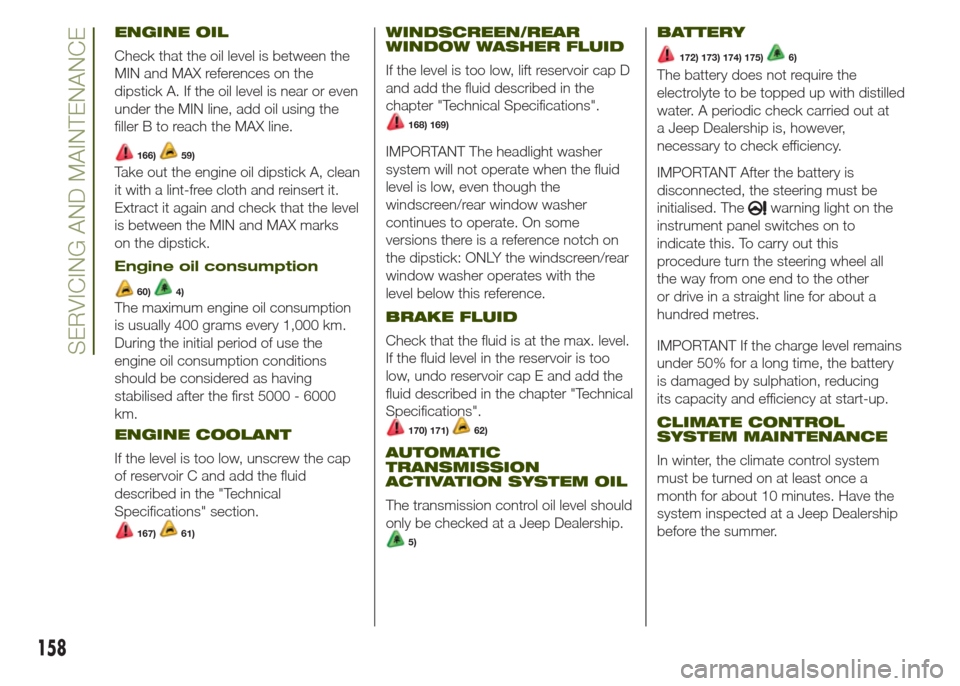
ENGINE OIL
Check that the oil level is between the
MIN and MAX references on the
dipstick A. If the oil level is near or even
under the MIN line, add oil using the
filler B to reach the MAX line.
166)59)
Take out the engine oil dipstick A, clean
it with a lint-free cloth and reinsert it.
Extract it again and check that the level
is between the MIN and MAX marks
on the dipstick.
Engine oil consumption
60)4)
The maximum engine oil consumption
is usually 400 grams every 1,000 km.
During the initial period of use the
engine oil consumption conditions
should be considered as having
stabilised after the first 5000 - 6000
km.
ENGINE COOLANT
If the level is too low, unscrew the cap
of reservoir C and add the fluid
described in the "Technical
Specifications" section.
167)61)
WINDSCREEN/REAR
WINDOW WASHER FLUID
If the level is too low, lift reservoir cap D
and add the fluid described in the
chapter "Technical Specifications".
168) 169)
IMPORTANT The headlight washer
system will not operate when the fluid
level is low, even though the
windscreen/rear window washer
continues to operate. On some
versions there is a reference notch on
the dipstick: ONLY the windscreen/rear
window washer operates with the
level below this reference.
BRAKE FLUID
Check that the fluid is at the max. level.
If the fluid level in the reservoir is too
low, undo reservoir cap E and add the
fluid described in the chapter "Technical
Specifications".
170) 171)62)
AUTOMATIC
TRANSMISSION
ACTIVATION SYSTEM OIL
The transmission control oil level should
only be checked at a Jeep Dealership.
5)
BATTERY
172) 173) 174) 175)6)
The battery does not require the
electrolyte to be topped up with distilled
water. A periodic check carried out at
a Jeep Dealership is, however,
necessary to check efficiency.
IMPORTANT After the battery is
disconnected, the steering must be
initialised. The
warning light on the
instrument panel switches on to
indicate this. To carry out this
procedure turn the steering wheel all
the way from one end to the other
or drive in a straight line for about a
hundred metres.
IMPORTANT If the charge level remains
under 50% for a long time, the battery
is damaged by sulphation, reducing
its capacity and efficiency at start-up.
CLIMATE CONTROL
SYSTEM MAINTENANCE
In winter, the climate control system
must be turned on at least once a
month for about 10 minutes. Have the
system inspected at a Jeep Dealership
before the summer.
158
SERVICING AND MAINTENANCE
Page 164 of 212

IMPORTANT In versions with a sun
roof, make sure that the sun roof is
closed before operating the window
washer jets.
Rear window washer
The rear window washer jets are fixed.
The nozzle holder is located above
the rear window.
WARNING
176)The air intake system (air cleaner,
rubber hoses, etc.) can be a protection in
the case of blowbacks from the engine.
DO NOT REMOVE this system unless you
need to carry out repair or servicing
operations. Before starting the engine
make sure the system is not dismantled:
failure to comply with this precaution
may cause serious injuries.
177)Exhaust emissions are very
dangerous and may be fatal. They contain
carbon monoxide, a colourless and
odourless gas which, if inhaled, may cause
fainting and poisoning.
178)The exhaust system can reach high
temperatures and cause a fire if the vehicle
is parked on flammable material. Dry grass
or leaves can also catch fire if they come
into contact with the exhaust system.
Do not park or use the vehicle in a place in
which the exhaust system might come
into contact with flammable material.
WARNING
64)Incorrect maintenance of the vehicle or
failure to carry out operations or repairs
(when necessary) may lead to more
expensive repairs, damage to other
components or a negative impact on the
vehicle performance. Have any operating
faults immediately checked by a Jeep
Dealership.
65)The vehicle is equipped with fluids
optimised for protecting its performance
and duration, and to extend servicing
intervals. Do not use chemicals for washing
these components since they may
damage the engine, the gearbox or the
climate control system. This damage is not
covered by the vehicleβs warranty. If, due
to malfunction of a component, washing is
needed, only use the fluid specific for
that procedure.
66)An excessive or insufficient amount of
oil in the block is extremely harmful for
the engine. Make sure it is always at an
adequate level.
67)Always require the use of only
compressor coolants and lubricants
approved and suitable for the specific air
conditioning system fitted on the vehicle.
Some non-approved coolants are
flammable and may explode, with the risk
of injuries. The use of non-approved
coolants or lubricants may adversely affect
system efficiency, leading to expensive
repairs.68)The air conditioning system contains
high-pressure coolant: to prevent damage
to people or the system, any topping-up
with fuel or repairs that involves
disconnection of the pipes must be carried
out by a Jeep Dealership.
69)Vehicles equipped with a catalytic
converter must be exclusively supplied with
unleaded petrol. Leaded petrol would
permanently damage the catalytic
converter and eliminate its ability to reduce
polluting emissions, seriously
compromising the engine performance,
which would be irreparably damaged. If the
engine does not work correctly, especially
if it starts irregularly or if there is a reduction
of its performance, immediately go to a
Jeep Dealership. Prolonged and faulty
operation of the engine may cause
overheating of the converter and, as a
consequence, possible damage to the
converter and the vehicle.
70)Using a gearbox fluid different from that
approved may compromise gearshifting
quality and/or cause vibration of the
gearbox itself.
71)It is recommended to have the vehicle
serviced by a Jeep Dealership. When
carrying out normal periodic operations
and small servicing interventions personally
on the vehicle, it is recommended to use
suitable equipment, original spare parts
and the necessary fluids. Do not carry out
any interventions if you don't have the
necessary experience.
162
SERVICING AND MAINTENANCE